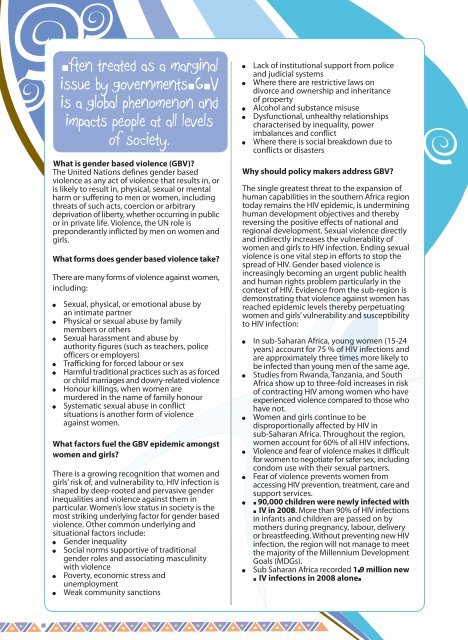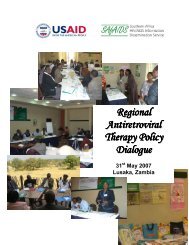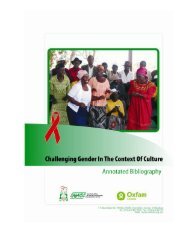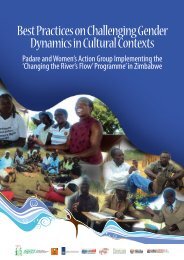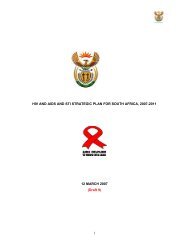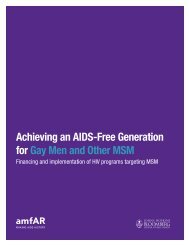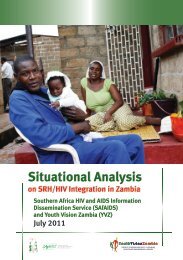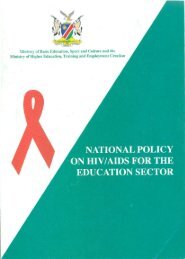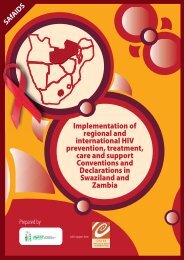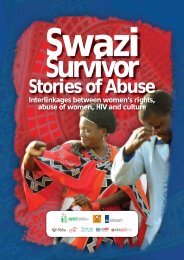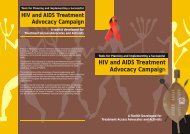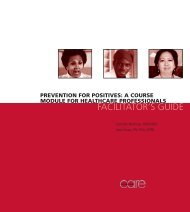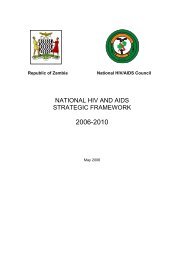Fact sheet on Gender based violence: A responsibility to ... - SAfAIDS
Fact sheet on Gender based violence: A responsibility to ... - SAfAIDS
Fact sheet on Gender based violence: A responsibility to ... - SAfAIDS
Create successful ePaper yourself
Turn your PDF publications into a flip-book with our unique Google optimized e-Paper software.
ften treated as a marginal<br />
issue by governments GV<br />
is a global phenomen<strong>on</strong> and<br />
impacts people at all levels<br />
of society.<br />
What is gender <strong>based</strong> <strong>violence</strong> (GBV)?<br />
The United Nati<strong>on</strong>s defines gender <strong>based</strong><br />
<strong>violence</strong> as any act of <strong>violence</strong> that results in, or<br />
is likely <strong>to</strong> result in, physical, sexual or mental<br />
harm or suffering <strong>to</strong> men or women, including<br />
threats of such acts, coerci<strong>on</strong> or arbitrary<br />
deprivati<strong>on</strong> of liberty, whether occurring in public<br />
or in private life. Violence, the UN role is<br />
prep<strong>on</strong>derantly inflicted by men <strong>on</strong> women and<br />
girls.<br />
What forms does gender <strong>based</strong> <strong>violence</strong> take?<br />
There are many forms of <strong>violence</strong> against women,<br />
including:<br />
Sexual, physical, or emoti<strong>on</strong>al abuse by<br />
an intimate partner<br />
Physical or sexual abuse by family<br />
members or others<br />
Sexual harassment and abuse by<br />
authority figures (such as teachers, police<br />
officers or employers)<br />
Trafficking for forced labour or sex<br />
Harmful traditi<strong>on</strong>al practices such as as forced<br />
or child marriages and dowry-related <strong>violence</strong><br />
H<strong>on</strong>our killings, when women are<br />
murdered in the name of family h<strong>on</strong>our<br />
Systematic sexual abuse in c<strong>on</strong>flict<br />
situati<strong>on</strong>s is another form of <strong>violence</strong><br />
against women.<br />
What fac<strong>to</strong>rs fuel the GBV epidemic am<strong>on</strong>gst<br />
women and girls?<br />
There is a growing recogniti<strong>on</strong> that women and<br />
girls’ risk of, and vulnerability <strong>to</strong>, HIV infecti<strong>on</strong> is<br />
shaped by deep-rooted and pervasive gender<br />
inequalities and <strong>violence</strong> against them in<br />
particular. Women’s low status in society is the<br />
most striking underlying fac<strong>to</strong>r for gender <strong>based</strong><br />
<strong>violence</strong>. Other comm<strong>on</strong> underlying and<br />
situati<strong>on</strong>al fac<strong>to</strong>rs include:<br />
<strong>Gender</strong> inequality<br />
Social norms supportive of traditi<strong>on</strong>al<br />
gender roles and associating masculinity<br />
with <strong>violence</strong><br />
Poverty, ec<strong>on</strong>omic stress and<br />
unemployment<br />
Weak community sancti<strong>on</strong>s<br />
Lack of instituti<strong>on</strong>al support from police<br />
and judicial systems<br />
Where there are restrictive laws <strong>on</strong><br />
divorce and ownership and inheritance<br />
of property<br />
Alcohol and substance misuse<br />
Dysfuncti<strong>on</strong>al, unhealthy relati<strong>on</strong>ships<br />
characterised by inequality, power<br />
imbalances and c<strong>on</strong>flict<br />
Where there is social breakdown due <strong>to</strong><br />
c<strong>on</strong>flicts or disasters<br />
Why should policy makers address GBV?<br />
The single greatest threat <strong>to</strong> the expansi<strong>on</strong> of<br />
human capabilities in the southern Africa regi<strong>on</strong><br />
<strong>to</strong>day remains the HIV epidemic, is undermining<br />
human development objectives and thereby<br />
reversing the positive effects of nati<strong>on</strong>al and<br />
regi<strong>on</strong>al development. Sexual <strong>violence</strong> directly<br />
and indirectly increases the vulnerability of<br />
women and girls <strong>to</strong> HIV infecti<strong>on</strong>. Ending sexual<br />
<strong>violence</strong> is <strong>on</strong>e vital step in efforts <strong>to</strong> s<strong>to</strong>p the<br />
spread of HIV. <strong>Gender</strong> <strong>based</strong> <strong>violence</strong> is<br />
increasingly becoming an urgent public health<br />
and human rights problem particularly in the<br />
c<strong>on</strong>text of HIV. Evidence from the sub-regi<strong>on</strong> is<br />
dem<strong>on</strong>strating that <strong>violence</strong> against women has<br />
reached epidemic levels thereby perpetuating<br />
women and girls’ vulnerability and susceptibility<br />
<strong>to</strong> HIV infecti<strong>on</strong>:<br />
In sub-Saharan Africa, young women (15-24<br />
years) account for 75 % of HIV infecti<strong>on</strong>s and<br />
are approximately three times more likely <strong>to</strong><br />
be infected than young men of the same age.<br />
Studies from Rwanda, Tanzania, and South<br />
Africa show up <strong>to</strong> three-fold increases in risk<br />
of c<strong>on</strong>tracting HIV am<strong>on</strong>g women who have<br />
experienced <strong>violence</strong> compared <strong>to</strong> those who<br />
have not.<br />
Women and girls c<strong>on</strong>tinue <strong>to</strong> be<br />
disproporti<strong>on</strong>ally affected by HIV in<br />
sub-Saharan Africa. Throughout the regi<strong>on</strong>,<br />
women account for 60% of all HIV infecti<strong>on</strong>s.<br />
Violence and fear of <strong>violence</strong> makes it difficult<br />
for women <strong>to</strong> negotiate for safer sex, including<br />
c<strong>on</strong>dom use with their sexual partners.<br />
Fear of <strong>violence</strong> prevents women from<br />
accessing HIV preventi<strong>on</strong>, treatment, care and<br />
support services.<br />
90,000 children were newly infected with<br />
$IV in 2008. More than 90% of HIV infecti<strong>on</strong>s<br />
in infants and children are passed <strong>on</strong> by<br />
mothers during pregnancy, labour, delivery<br />
or breastfeeding. Without preventing new HIV<br />
infecti<strong>on</strong>, the regi<strong>on</strong> will not manage <strong>to</strong> meet<br />
the majority of the Millennium Development<br />
Goals (MDGs).<br />
Sub Saharan Africa recorded 1)9 milli<strong>on</strong> new<br />
$IV infecti<strong>on</strong>s in 2008 al<strong>on</strong>e)


